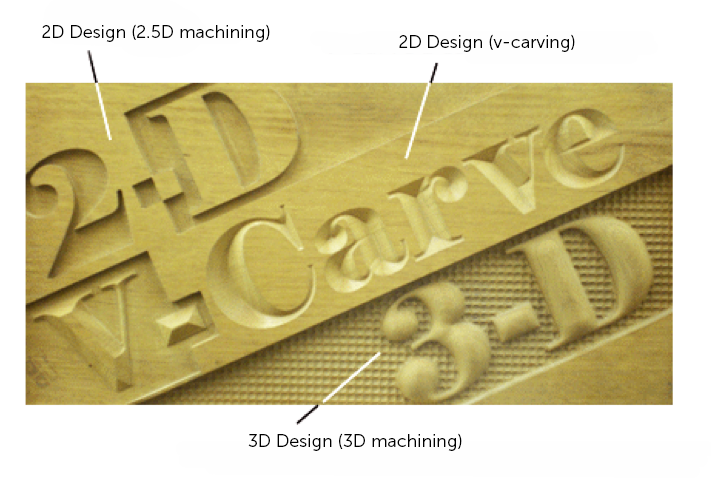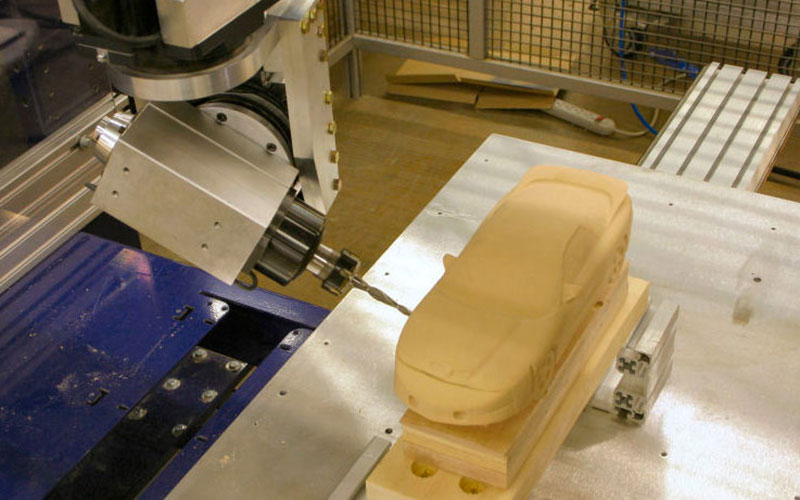ShopBot Tools will be closed for the July 4th Holiday on Thursday and Friday July 4 & 5. Holiday hours tech support is available.
Contact Tech Support via email: support@shopbottools.com
Contact Tech Support via email: support@shopbottools.com
A CNC (computer numeric control) tool is used in prototyping and full production for cutting, carving, machining and milling in a variety of materials including wood, mdf, plastics, foams and aluminum.

With a ShopBot CNC tool, you use the included software to design your parts on your personal computer, then, like a robot, the computer controls the cutter to precisely cut your parts. In the past, CNC tools were strictly industrial tools only used in large factory settings. Now, all the types of computer-driven tools that create things by cutting material away (such as CNCs or laser cutters) or building up material in layers to create an object (3D printing) are called digital fabrication tools. ShopBot's innovations in CNC technology have made these powerful tools affordable for individuals and small shops.
We make CNC tools for every situation imaginable, right down to completely customized machines designed to fit your exact specifications. Whether you’re looking to boost small business production, prototyping, or factory-level fabrication, there’s a ShopBot for your needs.
ShopBot Tools, like all CNC tools, move a cutter around a big table (X and Y axes) and move it up and down as well (Z axis) allowing it to make 3D movements and cut all sorts of shapes. The cutter looks like a drill bit and is spun by a motor called a router or spindle.
Unlike a drill bit, a router bit is designed to cut from the sides as well as the tip. By precisely moving the cutter through material, a ShopBot CNC tool can create virtually any pattern or shape and will do it in materials such as wood, plastic, foam, aluminum and many composites.
There Are Two Jobs for your Digital Fab Software: Creating Designs and Defining Toolpaths or CAD and CAM
There are two different jobs that software does for you in getting a project ready for production on your ShopBot:
This difference between designing and toolpathing are the basis for two types of software you may have heard of: CAD, computer-aided design; and CAM, computer-aided machining.
At one time, CAD and CAM software tended to be separate and you needed each type of software in order to complete your project. More recently, there has been an increase in software packages that combine both CAD and CAM functions as ours do.
There still remains a clear demarcation in the software between the CAD function of designing or laying out your project and the CAM function of planning how the cutting or machining will be done. The software that comes with your ShopBot will help you learn how to do both.
Sometimes you will have a simple drawing of something to be cut out. The design is drawn in a single flat plane. It is often drawn using the CAD functions of your software or with a CAD program (AutoCAD, for example). It can also be drawn with a “vector” drawing program (such as Adobe Illustrator). Whether a CAD design or vector drawing, it is essentially a flat, 2D plan of the project.
With this 2D plan, you will then use the CAM functions of the software to add information about the depth of cuts that are needed for the lines in the plan – frequently the depth will equal the thickness of the material. When the toolpath is generated by the CAM software, up and down movements are added to move the cutter in and out of the material for each cut. Further, the CAM functions can be used to have some areas of the plan cut or pocketed at different depths. So, while the design is a 2D plan, that plan is used to make a toolpath that has motion in all 3 directions, including the up and down actions of the vertical or “Z” axis. However, because the ups and downs tend to be straight movements in and out of the material, this type of work is sometimes considered 2.5D. Cutting plywood parts for cabinetmaking from a flat, 2D plan would be a good example of a 2D design turned into a 2.5D cutting project.
There is an additional and useful cutting technique that can be done with a 2D design file. It’s called “v-carving” because it makes use of a v-shaped cutter. This technique creates CNC motions with the v-shaped cutter that give an impressive chiseled look to lettering and other shapes. The CAM software uses the shape outlines in the 2D design to compute the 3D angled moves required to pull in and out of the material in such a way as to create a precise chiseled appearance with sharp corners. The design used for v-carving is still 2D in nature, but the actual CNC movements that create the effect involve full 3D, simultaneous XYZ motion of the cutter that can be quite complex. V-carving is a great way to add a more dramatic look to your lettering or sign work and decorative wood carvings. Because the layout process is still in 2D, it is relatively easy to create the designs and the v-carved letters can be cut fairly quickly.

In full 3D machining, your CNC cutter tip follows angled paths or 3D curves in order to mill or carve complex shapes. In 2.5D, your cutter may have been moving in 3 directions in situations like v-carving, but you were still thinking (designing) in 2D. In order to do fully sculptural 3D work, you need to think and design in 3D.
Designing in 3D is harder than 2D, but it takes full advantage of your CNC tool's capability to produce fully contoured shapes milled to your specifications. You will create the 3D shape of your concept in a 3D design system, defining the form that you want to cut.
This shape is called a 3D model, and the software programs that do this kind of work are usually called 3D modeling programs (sometimes 3D CAD). Modeling is the right word here, because rather than drawing with lines, you build up your 3D object by inserting and modifying 3D shapes. Note that visualizing and conceptualizing 3D shapes on a 2D computer screen is difficult and will probably involve using new and unfamiliar computer graphics tools for manipulating objects and surfaces in 3D space. If you do not already have experience with this type of CAD software, you should appreciate upfront that it is going to take a little time to get comfortable with it.
The shapes that you can model and machine in 3D are nearly unlimited – which is great. But this capability also means that CAM work can become more complex as a result of the wide range of machining strategies (different types of toolpathing actions) that become available. Because 3D work is often done in blocks of material of various sorts, thickness and varied material characteristics require extra attention for CAM planning and are a further challenge for 3D projects.

Toll Free: 1-888-680-4466
Phone: 919-680-4800
Fax: 919-680-4900
ShopBot Tools, Inc.
3333-B Industrial Drive
Durham, NC 27704
USA
Office Hours
Monday–Friday: 9am–5pm EST
After Hours Tech Support
Monday–Friday: 5pm–9pm EST
Saturday–Sunday: 10am–5pm EST
Office Closure
ShopBot Tools, Inc. is closed New Year’s Day, Memorial Day, July 4th, Labor Day,
Thanksgiving Day and the following Friday, and Christmas Eve and Christmas Day.
Outside of normal office hours, we regularly check for support requests,
email and phone messages. To make sure we can get back to you as soon as possible,
leave a phone number or return email address where you will be available.